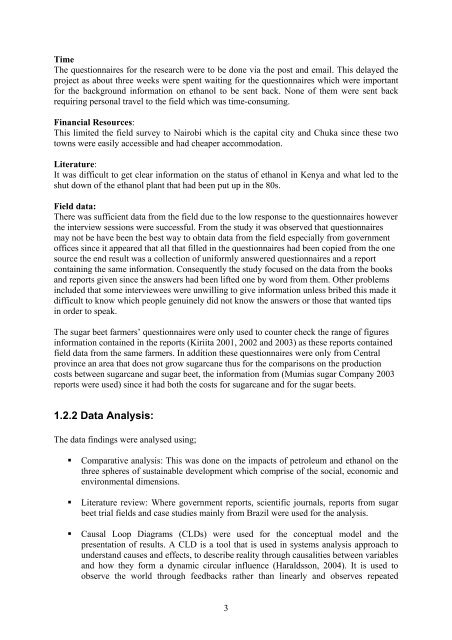ethanol fuel production and use in kenya for sustainable ... - lumes
ethanol fuel production and use in kenya for sustainable ... - lumes
ethanol fuel production and use in kenya for sustainable ... - lumes
You also want an ePaper? Increase the reach of your titles
YUMPU automatically turns print PDFs into web optimized ePapers that Google loves.
TimeThe questionnaires <strong>for</strong> the research were to be done via the post <strong>and</strong> email. This delayed theproject as about three weeks were spent wait<strong>in</strong>g <strong>for</strong> the questionnaires which were important<strong>for</strong> the background <strong>in</strong><strong>for</strong>mation on <strong>ethanol</strong> to be sent back. None of them were sent backrequir<strong>in</strong>g personal travel to the field which was time-consum<strong>in</strong>g.F<strong>in</strong>ancial Resources:This limited the field survey to Nairobi which is the capital city <strong>and</strong> Chuka s<strong>in</strong>ce these twotowns were easily accessible <strong>and</strong> had cheaper accommodation.Literature:It was difficult to get clear <strong>in</strong><strong>for</strong>mation on the status of <strong>ethanol</strong> <strong>in</strong> Kenya <strong>and</strong> what led to theshut down of the <strong>ethanol</strong> plant that had been put up <strong>in</strong> the 80s.Field data:There was sufficient data from the field due to the low response to the questionnaires howeverthe <strong>in</strong>terview sessions were successful. From the study it was observed that questionnairesmay not be have been the best way to obta<strong>in</strong> data from the field especially from governmentoffices s<strong>in</strong>ce it appeared that all that filled <strong>in</strong> the questionnaires had been copied from the onesource the end result was a collection of uni<strong>for</strong>mly answered questionnaires <strong>and</strong> a reportconta<strong>in</strong><strong>in</strong>g the same <strong>in</strong><strong>for</strong>mation. Consequently the study foc<strong>use</strong>d on the data from the books<strong>and</strong> reports given s<strong>in</strong>ce the answers had been lifted one by word from them. Other problems<strong>in</strong>cluded that some <strong>in</strong>terviewees were unwill<strong>in</strong>g to give <strong>in</strong><strong>for</strong>mation unless bribed this made itdifficult to know which people genu<strong>in</strong>ely did not know the answers or those that wanted tips<strong>in</strong> order to speak.The sugar beet farmers’ questionnaires were only <strong>use</strong>d to counter check the range of figures<strong>in</strong><strong>for</strong>mation conta<strong>in</strong>ed <strong>in</strong> the reports (Kiriita 2001, 2002 <strong>and</strong> 2003) as these reports conta<strong>in</strong>edfield data from the same farmers. In addition these questionnaires were only from Centralprov<strong>in</strong>ce an area that does not grow sugarcane thus <strong>for</strong> the comparisons on the <strong>production</strong>costs between sugarcane <strong>and</strong> sugar beet, the <strong>in</strong><strong>for</strong>mation from (Mumias sugar Company 2003reports were <strong>use</strong>d) s<strong>in</strong>ce it had both the costs <strong>for</strong> sugarcane <strong>and</strong> <strong>for</strong> the sugar beets.1.2.2 Data Analysis:The data f<strong>in</strong>d<strong>in</strong>gs were analysed us<strong>in</strong>g;• Comparative analysis: This was done on the impacts of petroleum <strong>and</strong> <strong>ethanol</strong> on thethree spheres of susta<strong>in</strong>able development which comprise of the social, economic <strong>and</strong>environmental dimensions.• Literature review: Where government reports, scientific journals, reports from sugarbeet trial fields <strong>and</strong> case studies ma<strong>in</strong>ly from Brazil were <strong>use</strong>d <strong>for</strong> the analysis.• Causal Loop Diagrams (CLDs) were <strong>use</strong>d <strong>for</strong> the conceptual model <strong>and</strong> thepresentation of results. A CLD is a tool that is <strong>use</strong>d <strong>in</strong> systems analysis approach tounderst<strong>and</strong> ca<strong>use</strong>s <strong>and</strong> effects, to describe reality through causalities between variables<strong>and</strong> how they <strong>for</strong>m a dynamic circular <strong>in</strong>fluence (Haraldsson, 2004). It is <strong>use</strong>d toobserve the world through feedbacks rather than l<strong>in</strong>early <strong>and</strong> observes repeated3
















